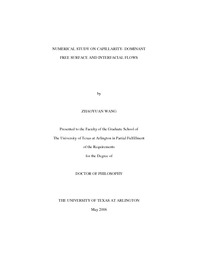
ATTENTION: The works hosted here are being migrated to a new repository that will consolidate resources, improve discoverability, and better show UTA's research impact on the global community. We will update authors as the migration progresses. Please see MavMatrix for more information.
Show simple item record
| dc.contributor.author | Wang, Zhaoyuan | en_US |
| dc.date.accessioned | 2007-08-23T01:56:28Z | |
| dc.date.available | 2007-08-23T01:56:28Z | |
| dc.date.issued | 2007-08-23T01:56:28Z | |
| dc.date.submitted | April 2006 | en_US |
| dc.identifier.other | DISS-1228 | en_US |
| dc.identifier.uri | http://hdl.handle.net/10106/318 | |
| dc.description.abstract | The continuum surface force (CSF) method has been extensively employed in the volume-of-fluid (VOF), level set (LS) and front tracking methods to model surface tension forces. Its ability is limited for the surface tension dominant free surface and interfacial flows due to the existence of spurious currents. These currents may lead to disastrous interface instabilities and failure of grid convergence, which are present in all the previous versions of the CSF algorithm. In this study, a coupled level set and volume-of-fluid method (CLSVOF) is employed for interface tracking, which offers more accurate computations of the curvature and the normal vector and excellent mass conservation properties. The surface tension is modeled by a new surface tension implementation algorithm, referred to as the pressure boundary method (PBM). The surface tension effect is incorporated into the Navier-Stokes equation via a capillary pressure gradient term in the first step of a two-step projection method.
The accuracy and capability of the present algorithms are tested and validated by a series of numerical experiments carried out for both free surface and two-phase interfacial flows. The CLSVOF method demonstrates superiority over the VOF method in surface tension modeling. It has been shown that the PBM method drastically suppresses the spurious currents with the sharp pressure jump condition preserved. The robustness of the PBM method on interfacial flows with large density ratios has also been exhibited. The CLSVOF and PBM methods have been applied to study the pinch-off mechanism of a pendant droplet, the relaxation of an elongated liquid ligament and the dynamics of a gas bubble rising in a vertical tube. The results of the simulations are compared with data from the experimental and theoretical measurements available in the literature, and good agreement has been achieved. The accuracy, robustness and capability of the current numerical methods are further validated through these applications. | en_US |
| dc.description.sponsorship | Tong, Albert Y. | en_US |
| dc.language.iso | EN | en_US |
| dc.publisher | Mechanical Engineering | en_US |
| dc.title | Numerical Study On Capillarity- Dominant Free Surface And Interfacial Flows | en_US |
| dc.type | Ph.D. | en_US |
| dc.contributor.committeeChair | Tong, Albert Y. | en_US |
| dc.degree.department | Mechanical Engineering | en_US |
| dc.degree.discipline | Mechanical Engineering | en_US |
| dc.degree.grantor | University of Texas at Arlington | en_US |
| dc.degree.level | doctoral | en_US |
| dc.degree.name | Ph.D. | en_US |
| dc.identifier.externalLink | https://www.uta.edu/ra/real/editprofile.php?onlyview=1&pid=277 | |
| dc.identifier.externalLinkDescription | Link to Research Profiles | |
Files in this item
- Name:
- umi-uta-1228.pdf
- Size:
- 4.410Mb
- Format:
- PDF
This item appears in the following Collection(s)
Show simple item record


